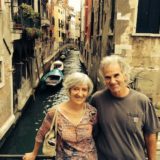I enjoy being in situations that defy common wisdom. Recently my husband and I were vacationing in Italy, where we spent one day in Venice. We traveled there by train, and simply walked off the train and started wandering around (fortunately, the places most people want to go are pretty well sign-posted, or you’d be irretrievably lost after about five minutes.)
 At one point a sweet young Dutch woman asked us to take her picture, and then we asked her to return the favor. It wasn’t until we were standing there, not moving, that I realized how quiet the city was. I said as much to my husband, and he responded, “no cars.”
At one point a sweet young Dutch woman asked us to take her picture, and then we asked her to return the favor. It wasn’t until we were standing there, not moving, that I realized how quiet the city was. I said as much to my husband, and he responded, “no cars.”
Of course! How strange to be in an urban area completely devoid of traffic sounds and smells. The only motorized vehicles in Venice are the water taxis, which are pretty quiet.
Once we’d been reminded of this auto-less situation, we noticed all kinds of interesting adaptations: a cool little machine shaped kind of like the bottom of an army tank that some guys were using to take a refrigerator up a set of stairs; a dolly with a second smaller set of wheels to transport containers not only through the streets but up one side of the stepped bridges and down the other.
The experience immediately made me think about how we might do things differently in other cities to reduce or eliminate car traffic. I noticed how just one example of a non-car-based urban area shifted my thinking from “We couldn’t possibly do without cars” to “Why not?”
Now, don’t misunderstand me — I’m sure there are thousands of people infinitely more equipped to think about this question than I, who have been wrestling with it for many years. I’m not really talking about how to create car-free cities; I’m talking about how to challenge your assumptions. And this day in Venice reminded me that when I encounter something that pushes against what I believe is possible (it could be anything: a conservative Republican who’s concerned about social justice; a simple approach to income taxes that will actually work; a way to stay in shape that takes 15 minutes a day), it has — if I’m open to it — a wonderful effect of making me question my set-in-stone assumptions. And that’s always a good thing.
And to have my mind opened up in addition to simply being in Venice: priceless.
